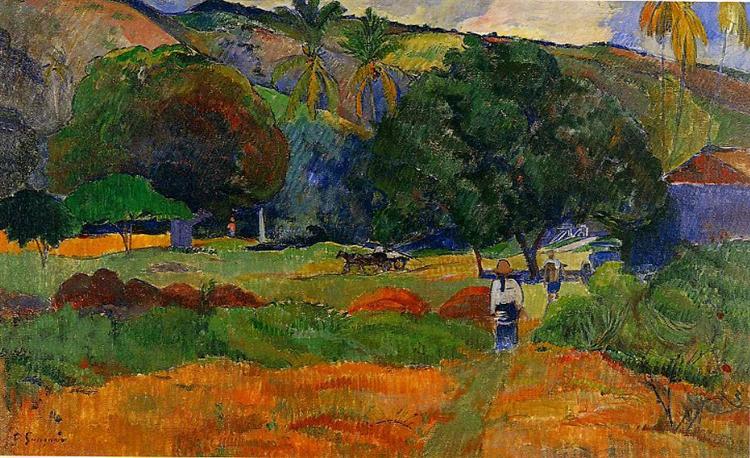Descrição
Em "The Little Valley", pintado em 1891, Paul Gauguin expressa sua profunda conexão com a natureza e sua busca por paisagens que evocam uma sensação de tranquilidade e espiritualidade. Este trabalho, que faz parte de seu tumultuoso período de exploração artística e a influência de sua estadia no Taiti, oferece uma janela para sua visão particular do mundo, enquanto refletia sua experimentação com a forma e a cor.
A composição de "The Small Valley" é notável por sua simplicidade e elegância. O trabalho apresenta uma paisagem que fica em uma encosta suave, onde você pode ver árvores folhosas que enquadram a cena. O verde vibrante da vegetação, combinado com o pôr do sol em tons quentes, criam uma sensação de calma que quase convida o espectador a experimentar uma conexão íntima com o ambiente. Gauguin usa uma paleta de cores saturadas e não naturais, um selo distinto de seu estilo, que lhe permite evocar emoções mais do que fielmente gravar realidade.
No coração de a pintura Há um pequeno vale, representado de maneira estilizada e abstrata. Linhas curvas e formas simplificadas revelam uma abordagem mais simbólica e menos descritiva, que é característica no trabalho do artista. Essa simbiose entre o figurativo e o resumo é um testemunho de sua abordagem pós -impressionista, na qual usa a cor e a maneira de transmitir mais do que detalhes precisos. A leveza das nuvens que deslizam no céu sugere um movimento lento e plácido, enquanto a disposição geral dos elementos convida a contemplação e a introspecção.
O uso da cor em "The Small Valley" é particularmente intrigante. Gauguin opta por tons que não compõem estritamente a observação usual, escolhendo combinações que transmitem uma carga emocional. O verde e o marrom da Terra se opõem ao azul macio do céu e ao amarelo do sol oeste, criando um contraste que enriquece a experiência visual. A escolha dessas cores, além de sua função descritiva, sugere uma profunda conexão com simbolismo e ciclos naturais, permitindo que o espectador mergulhe em um estado contemplativo que ressoou com a ideologia artística de Gauguin.
Aqui pintura Não há figuras humanas visíveis, o que reforça a idéia de um mundo natural calmo e desconectado da vida urbana na qual Gauguin havia vivido anteriormente. Essa ausência de personagens pode ser interpretada como uma afirmação do desejo do artista por uma conexão mais pura e elementar com a paisagem, um refúgio da complexidade da vida moderna. Essa abordagem ressoa com a necessidade de Gauguin de encontrar um senso de identidade e significado em um ambiente longe das convenções ocidentais.
À medida que o trabalho avança, você pode ver a influência que Gauguin recebeu das tradições artísticas indígenas e seu desejo de transcender os limites da arte européia convencional. Ele foi pioneiro no simbolismo na arte, e seu estilo único influenciou numerosos movimentos posteriores, incluindo fauvismo e expressionismo. "The Little Valley" captura essa essência da exploração e experimentação, oferecendo um espaço onde o espectador pode refletir sobre a natureza, a espiritualidade e a busca por uma maneira na vida cotidiana.
Em conclusão, "The Little Valley" é um pintura que encapsula os ideais artísticos e filosóficos de Paul Gauguin, apresentando uma rica paleta de cores e uma paisagem evocativa que desafia a percepção e a interpretação. É uma obra que não apenas representa uma imagem do mundo natural, mas também uma manifestação do desejo do artista de explorar e entender um espaço além das limitações da técnica e do tempo, tornando -o eterno em sua essência.
KUADROS ©, um pintura famoso em sua parede.
Reproduções de pinturas petróleo feito à mão, com a qualidade dos artistas profissionais e o selo distinto de KUADROS ©.
Serviço de reprodução de imagens com garantia de satisfação. Se você não está completamente satisfeito com a réplica de seu pintura, Reembolsamos seu dinheiro 100%.

